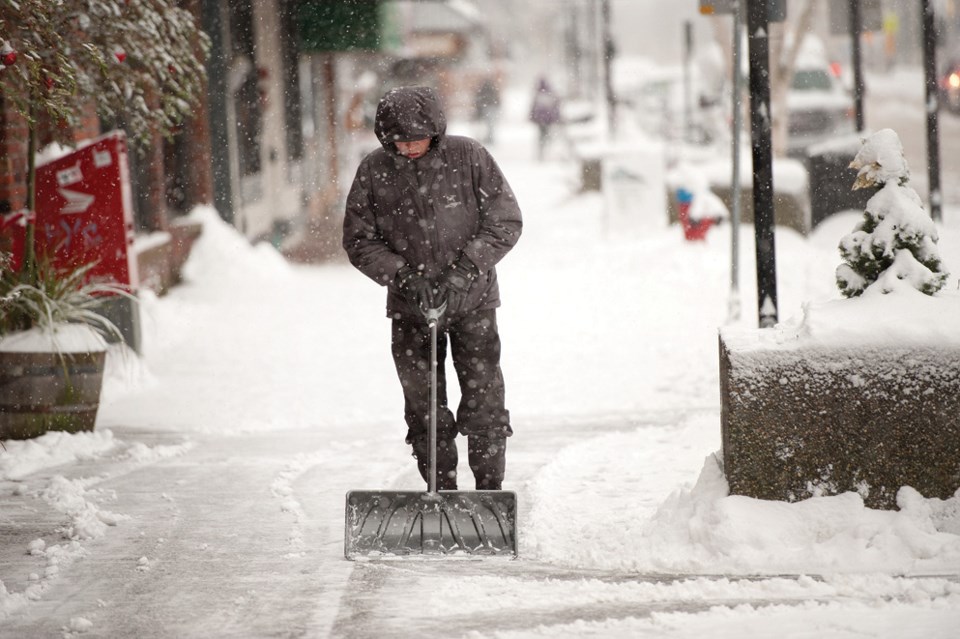Longtime Garibaldi Highlands resident Ueli Liechti says the roads around his home were not adequately plowed this winter.
During the snowstorm in early February some intersections were impassable because of the snow and nearby cul-de-sacs had so much snow that emergency vehicles would not be able to get through, he said.
Liechti used his own excavator to push through the white stuff on some streets and cleared several neighbours’ driveways.
Historically, cul-de-sacs and side streets had been left unattended for three to four days in his neighborhood, Liechti told council in a recent email he forwarded to The Chief. “Nothing has changed,” he said of this winter.
“With all due respect to District of Squamish staff and employees, the taxpayer should expect a thorough review of the snow clearing operations,” said Liechti.
There’s no denying extra snowfall this year caused some havoc in Squamish.
Student pilot Warwick Patterson also wrote to council to complain about snow plowing, but at the airport.
The Squamish runway was left unplowed for days during a mid-February snowfall, he said. “Aside from the frustration and inconvenience this causes private pilots, this extended closure is hurting Squamish tourism and businesses, said Patterson in the letter to council.
This winter delivered a total of 185 centimetres of snow to Squamish, making it one of the snowiest winters since the late 1980s, according to Jason Ross of Environment Canada.
This winter, District costs to date to deal with snow and ice are already at 65 per cent of the total costs for 2016 ($353,200), according to Christina Moore, communications manager for the District. And 2016 costs were up 89 per cent over 2015 ($186,650), which was considered a lighter year for snow and ice.
The District fielded complaints about plowing and salting and delays in clearing the airport runway this winter, acknowledged Bob Smith, director of operations with the District of Squamish.
The District sets out priority areas to clear first: areas on hills and that are essential for emergency vehicles, he explained. Side roads and cul-de-sacs are not top priorities, he acknowledged.
“There are going to be flat areas and cul-de-sacs that will be left,” Smith said, adding that during one snow event this year District crews jumped from hill to hill over an eight-hour period because the snow was incessant.
Smith said some of the new developments in Squamish, such as in the Crumpit Woods development of single-family homes on a steep hill, add to the burden on snow clearing crews.
“As soon as we get those steep hillsides, we have got to get [our] people there,” said Smith.
Coun. Susan Chapelle said she found it frustrating the low-density new developments were a priority over the higher density, flatter areas.
“You’ve got to realize if you are building a house on a hill there’s going to be challenges and having to wait a little bit while we get denser areas and safe routes to school done first,” she said.
In terms of the airport, Smith acknowledged that during a mid-February snowfall the usual District protocol wasn’t followed.
Usually someone would call from the airport and the runway would get on the list to be plowed, Smith said. The message didn’t get through during that particular snowfall, he said.
Reached late last, week Patterson told The Chief the airport was indeed plowed more quickly during snow events since the snowfall he complained about in his letter.
“I just don’t think the airport was on anyone’s radar and/or [ they didn’t] realize that an unplowed airport meant lost business,” he said.
Generally speaking though, the airport isn’t the District’s first priority, Smith said.
“We ensure that those red [main] routes are clear and that the drainage is clear and once that is taken care of for the community then we consider the airport,” he said.
It takes four to six hours to clear the airport using a loader and a dump truck, according to Smith.
A plan is in place to make the snow season better for residents next year, Smith said.
The current snow and ice policy, which dates back to 2008, will be reviewed and updated.
An approximately $210,000 new sidewalk and trail maintenance machine is in the District budget for 2017, which should improve things during the next “Snowmageddon.”
The objective for next winter is to have the routes to school open by 8 a.m. during snow events.
The senior centre and other areas around downtown will be additional priorities.
Coun. Ted Prior noted that storeowners and homeowners are responsible for keeping the areas around their businesses cleared.
But Coun. Doug Race noted that the current bylaw only obligates property owners whose property is being used for business or residential uses to clear in and around their businesses, which means that the owners of empty lots weren’t necessarily obligated to plow around their property.
Council directed District staff to bring back an amended traffic bylaw that extends the obligation to those whose lots may be sitting unused.




